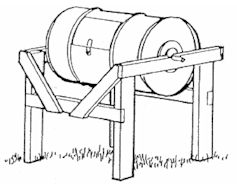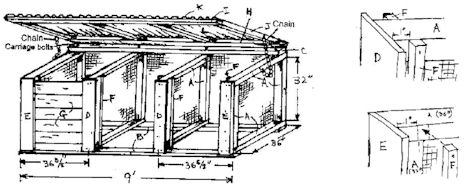Composting Basics

It’s easy to learn how to compost. The process can be as high tech or low maintenance as you wish to make it.
Passive composting
With passive composting, you just throw everything in a pile and leave it for a year or two. Nature will take its course and break the materials down into humus. No bin, specific mix of materials, temperature taking, or turning required.
Active composting
Fast or "active" composting can be completed in two to six weeks. This approach requires attention to five key areas:
Carbon vs. nitrogen
Carbon and nitrogen are the two fundamental elements in composting, and their ratio (C:N) is important. The decomposing organisms use carbon as a source of energy and nitrogen for building cell structure. They require more carbon than nitrogen so you should put more carbon than nitrogen items in your bin. The ideal ratio is 30 parts carbon to 1 part nitrogen (30:1) by weight. Too little nitrogen causes the composting process to slow; too much nitrogen may cause odors due to the generation of ammonia gas.
Leaves are a good source of carbon; fresh grass, manures and blood meal are sources of nitrogen. Common carbon and nitrogen sources are listed below:
Carbon sources
- Dry straw-like grass
- Dry leaves
- Sawdust, woodchips
- Paper, cardboard
- Shrub prunings
- Cotton and wool rags
Nitrogen sources
- Green plant material
- Manure from non-meat eating animals
- Fruit and vegetable scraps
- Seaweed (rinsed with fresh water)
Some of your food scraps are harder to compost and may attract animals and pathogens, which cause disease. Therefore, don’t put the following items in your compost pile:
- Meats or bones
- Fish
- Dairy foods
- Fats
- Grease
- Oils
- Diseased plants
- Pet litter and excrement from meat eating animals
Water
Your compost pile needs to be kept moist because the decomposing microorganisms can only use organic molecules if they are dissolved in water. However, too much water can cause odors. You can use the "squeeze test" to gauge the moisture content of your compost pile. A handful of squeezed material should have the moisture content of a well wrung sponge. You can also tell if your pile is too dry if the material is just sitting there, not breaking down. Add water if your pile is too dry. If it’s too wet, you can correct it by turning it or by adding dry materials.
Air
The decomposition process requires oxygen. Turning your compost pile adds oxygen and brings newly added material into contact with microbes. It can be done with a pitchfork, a shovel, or a hoe. Mix or turn the pile weekly for optimal results. You’ll know your bin is not getting enough oxygen if the pile smells of ammonia.
Surface area
You can speed up the composting process by increasing the surface area materials to be composted by chopping, shredding, mowing, or breaking up the material. Smaller pieces (particle size) compost more quickly. The increased surface area allows the microorganisms to digest more material, multiply more quickly, and generate more heat. It’s not necessary to increase the surface area, but doing so will speed up the process. Insects and earthworms in compost piles also break down materials into smaller particles that bacteria and fungi can then digest.
Temperature
Microorganisms generate heat as they decompose organic material. A compost pile with temperatures between 90° and 140°F (32°-60°C) is composting efficiently. Temperatures higher than 140°F (60°C) inhibit the activity of many of the most important and active organisms in the pile. Your pile will still compost at temperatures below 90°, it will just compost more slowly.
Containing Your Compost
There are a many different options for containing your compost but there are some optimal bins sizes. A compost bin should be between 3 feet x 3 feet x 3 feet and 5 feet x 5 feet x 5 feet. A bin that is too small can’t retain enough heat while a bin that is too large won’t allow enough air to reach the center of the pile.
You don’t even have to use a bin, you can simply make your compost pile in a convenient spot on the ground or in a shallow pit. You can also build a bin from available materials such as pallets, two-by-fours and plywood, or wire mesh. There are also many commercial bins on the market available through mail order.
Make your own bin

Using readily available materials such as wooden pallets, you can build your own compost bin. Click on the links below to find instructions to make different types of compost bins:
- Wooden pallet compost bin
- Wood and wire compost bin
- Concrete block compost bin(s)
- Wire mesh compost bin
- Wooden three bin compost unit
- Can compost bin
- Barrel composter
You Have Compost. Now What?
When the composted material looks like rich, brown soil and has an earthy smell, it is ready to use. When fully composted, most of the original materials should be unrecognizable, although small pieces of hard-to-decompose materials (such as straw or eggshells) may be visible.
There are many general advantages to using compost. It improves soil structure, texture, and aeration and increases the soil's water-holding capacity. Adding compost improves soil fertility and stimulates healthy root development in plants. The organic matter provided in compost also provides food for microorganisms, which keeps the soil in a healthy, balanced condition. Nitrogen, potassium, and phosphorus will be produced naturally by the feeding of microorganisms, reducing the need for other soil additives.
Compost provides specific benefits for Guam’s soil. Tropical and subtropical soils lack organic material, according to Florida’s Online Composting Center. While temperate soils may have up to 50 percent organic matter, sub-tropical soils typically have 1 percent or less. Applying compost can help raise organic matter in soils. Compost can also help replace the easily eroded soils of Guam.
Since the soil never freezes in tropical climates, microbial soil activity continues year-round, quickly using up organic matter in the soil. High rainfall and high temperatures also contribute to this rapid decomposition of organic matter. You can help replace that organic matter and maintain good soil by adding compost annually.
Compost can be mixed into the soil before planting by applying 1 to 3 inches of compost to the soil surface and working into the soil to a depth of about 3 – 4 inches. It can be used as a mulch or topdressing around flowers, vegetables, shrubs and trees. Compost may also be used as lawn topdressing.
You can learn more about composting from the website of Dr. Mohammad Golabi, a soil scientist and Program Chair for the interdisciplinary Environmental Science Graduate Program at the University of Guam. Dr. Golabi is developing composting technology as an organics waste management strategy and researching ways to use compost as an alternative to synthetic fertilizers as part of his ongoing research.


 PAY ONLINE
PAY ONLINE
